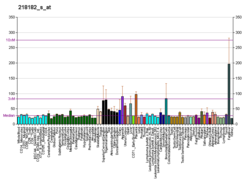クローディン1
表示
クローディン1(英: claudin-1)は、約23 kDa(キロダルトン)の膜タンパク質である。細胞膜を4回貫通しており、N末端とC末端は細胞質にある。C末端のチロシン-バリンを含む保存されたPDZ結合モチーフを介してタイトジャンクション裏打ちタンパク質のZO-1と結合する[5]。
機能と疾患
[編集]クローディン1は、クローディンファミリーの一つでタイトジャンクションの主要構成成分である。特に、皮膚や肝臓に発現が多い[6][7]。
クローディン1のノックアウトマウスは、皮膚のタイトジャンクションのバリア機能異常により生後1日以内に脱水で死亡する[8]。
また、オクルディンとともにC型肝炎ウイルスの受容体として知られる[9]。
発見の経緯
[編集]クローディン1は1998年に京都大学の月田承一郎らのグループによって報告された[6]。
脚注
[編集]- ^ a b c GRCh38: Ensembl release 89: ENSG00000163347 - Ensembl, May 2017
- ^ a b c GRCm38: Ensembl release 89: ENSMUSG00000022512 - Ensembl, May 2017
- ^ Human PubMed Reference:
- ^ Mouse PubMed Reference:
- ^ Itoh M, Furuse M, Morita K, Kubota K, Saitou M, Tsukita S. Direct binding of three tight junction-associated MAGUKs, ZO-1, ZO-2, and ZO-3, with the COOH termini of claudins. J Cell Biol, 147(6): 1351-63, 1999. PMID 10601346
- ^ a b Furuse M, Fujita K, Hiiragi T, Fujimoto K, Tsukita Sh. Claudin-1 and-2: novel integral membrane proteins localizing at tight junctions with no sequence similarity to occludin. J Cell Biol, 141(7): 1539-50, 1998. PMID 9647647
- ^ Morita K, Sasaki H, Fujimoto K, Furuse M, Tsukita Sh. Claudin multigene family encoding four-transmembrane domain protein components of tight junction strands. Proc Natl Acad Sci USA, 96(2): 511-6, 1999. PMID 9892664
- ^ Furuse M, Hata M, Furuse K, Yoshida Y, Haratake A, Sugitani Y, Noda T, Kubo A, Tsukita Sh. Claudin-based tight junctions are crucial for the mammalian epidermal barrier: a lesson from claudin-1-deficient mice. J Cell Biol, 156(6): 1099-111, 2002. PMID 11889141
- ^ Evans MJ, von Hahn T, Tscherne DM, Syder AJ, Panis M, Wölk B, Hatziioannou T, McKeating JA, Bieniasz PD, Rice CM. Nature, 446(7237):801-5, 2007 PMID 17325668
参考文献
[編集]- “Tight junctions of the blood-brain barrier”. Cell. Mol. Neurobiol. 20 (1): 57–76. (2000). doi:10.1023/A:1006995910836. PMID 10690502.
- “The roles of claudin superfamily proteins in paracellular transport”. Traffic 2 (2): 93–8. (2001). doi:10.1034/j.1600-0854.2001.020203.x. PMID 11247307.
- “Multifunctional strands in tight junctions”. Nat. Rev. Mol. Cell Biol. 2 (4): 285–93. (2001). doi:10.1038/35067088. PMID 11283726.
- “Claudin-based barrier in simple and stratified cellular sheets”. Curr. Opin. Cell Biol. 14 (5): 531–6. (2002). doi:10.1016/S0955-0674(02)00362-9. PMID 12231346.
- “Tight junction proteins”. Prog. Biophys. Mol. Biol. 81 (1): 1–44. (2003). doi:10.1016/S0079-6107(02)00037-8. PMID 12475568.
- “Role of claudins in tumorigenesis”. Adv. Drug Deliv. Rev. 57 (6): 919–28. (2005). doi:10.1016/j.addr.2005.01.006. PMID 15820559.
- “HIV tat and neurotoxicity”. Microbes Infect. 8 (5): 1347–57. (2006). doi:10.1016/j.micinf.2005.11.014. PMID 16697675.
- “Reliance of host cholesterol metabolic pathways for the life cycle of hepatitis C virus”. PLOS Pathog. 3 (8): e108. (2007). doi:10.1371/journal.ppat.0030108. PMC 1959368. PMID 17784784.
- “Claudin-1 and -2: novel integral membrane proteins localizing at tight junctions with no sequence similarity to occludin”. J. Cell Biol. 141 (7): 1539–50. (1998). doi:10.1083/jcb.141.7.1539. PMC 2132999. PMID 9647647.
- “SEMP1, a senescence-associated cDNA isolated from human mammary epithelial cells, is a member of an epithelial membrane protein superfamily”. Gene 226 (2): 285–95. (1999). doi:10.1016/S0378-1119(98)00553-8. PMID 9931503.
- “Manner of interaction of heterogeneous claudin species within and between tight junction strands”. J. Cell Biol. 147 (4): 891–903. (1999). doi:10.1083/jcb.147.4.891. PMC 2156154. PMID 10562289.
- “Direct binding of three tight junction-associated MAGUKs, ZO-1, ZO-2, and ZO-3, with the COOH termini of claudins”. J. Cell Biol. 147 (6): 1351–63. (1999). doi:10.1083/jcb.147.6.1351. PMC 2168087. PMID 10601346.
- “Genomic organization of claudin-1 and its assessment in hereditary and sporadic breast cancer”. Hum. Genet. 107 (3): 249–56. (2000). doi:10.1007/s004390000375. PMID 11071387.
- “Claudin promotes activation of pro-matrix metalloproteinase-2 mediated by membrane-type matrix metalloproteinases”. J. Biol. Chem. 276 (30): 28204–11. (2001). doi:10.1074/jbc.M103083200. PMID 11382769.
- “Multi-PDZ domain protein 1 (MUPP1) is concentrated at tight junctions through its possible interaction with claudin-1 and junctional adhesion molecule”. J. Biol. Chem. 277 (1): 455–61. (2002). doi:10.1074/jbc.M109005200. PMID 11689568.
- “A systems proteomics view of the endogenous human claudin protein family”. J Proteome Res 15 (2): 339–359. (2015). doi:10.1021/acs.jproteome.5b00769. PMC 4777318. PMID 26680015.





